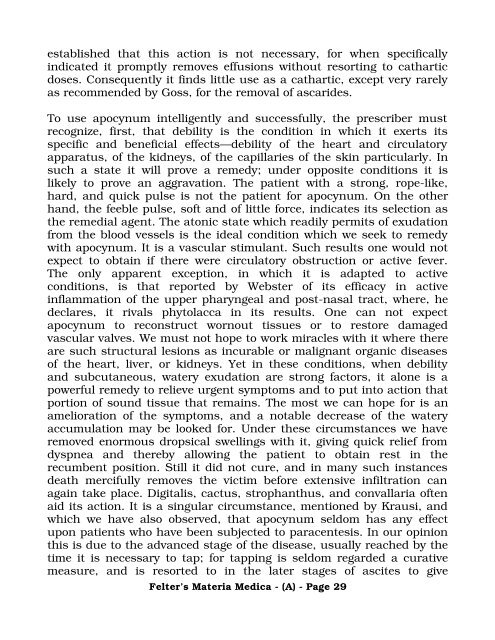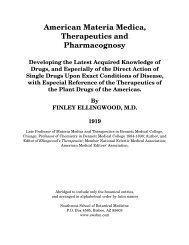Individual Drugs. ABIES (Tsuga canadensis). - Southwest School of ...
Individual Drugs. ABIES (Tsuga canadensis). - Southwest School of ...
Individual Drugs. ABIES (Tsuga canadensis). - Southwest School of ...
Create successful ePaper yourself
Turn your PDF publications into a flip-book with our unique Google optimized e-Paper software.
established that this action is not necessary, for when specifically<br />
indicated it promptly removes effusions without resorting to cathartic<br />
doses. Consequently it finds little use as a cathartic, except very rarely<br />
as recommended by Goss, for the removal <strong>of</strong> ascarides.<br />
To use apocynum intelligently and successfully, the prescriber must<br />
recognize, first, that debility is the condition in which it exerts its<br />
specific and beneficial effects—debility <strong>of</strong> the heart and circulatory<br />
apparatus, <strong>of</strong> the kidneys, <strong>of</strong> the capillaries <strong>of</strong> the skin particularly. In<br />
such a state it will prove a remedy; under opposite conditions it is<br />
likely to prove an aggravation. The patient with a strong, rope-like,<br />
hard, and quick pulse is not the patient for apocynum. On the other<br />
hand, the feeble pulse, s<strong>of</strong>t and <strong>of</strong> little force, indicates its selection as<br />
the remedial agent. The atonic state which readily permits <strong>of</strong> exudation<br />
from the blood vessels is the ideal condition which we seek to remedy<br />
with apocynum. It is a vascular stimulant. Such results one would not<br />
expect to obtain if there were circulatory obstruction or active fever.<br />
The only apparent exception, in which it is adapted to active<br />
conditions, is that reported by Webster <strong>of</strong> its efficacy in active<br />
inflammation <strong>of</strong> the upper pharyngeal and post-nasal tract, where, he<br />
declares, it rivals phytolacca in its results. One can not expect<br />
apocynum to reconstruct wornout tissues or to restore damaged<br />
vascular valves. We must not hope to work miracles with it where there<br />
are such structural lesions as incurable or malignant organic diseases<br />
<strong>of</strong> the heart, liver, or kidneys. Yet in these conditions, when debility<br />
and subcutaneous, watery exudation are strong factors, it alone is a<br />
powerful remedy to relieve urgent symptoms and to put into action that<br />
portion <strong>of</strong> sound tissue that remains. The most we can hope for is an<br />
amelioration <strong>of</strong> the symptoms, and a notable decrease <strong>of</strong> the watery<br />
accumulation may be looked for. Under these circumstances we have<br />
removed enormous dropsical swellings with it, giving quick relief from<br />
dyspnea and thereby allowing the patient to obtain rest in the<br />
recumbent position. Still it did not cure, and in many such instances<br />
death mercifully removes the victim before extensive infiltration can<br />
again take place. Digitalis, cactus, strophanthus, and convallaria <strong>of</strong>ten<br />
aid its action. It is a singular circumstance, mentioned by Krausi, and<br />
which we have also observed, that apocynum seldom has any effect<br />
upon patients who have been subjected to paracentesis. In our opinion<br />
this is due to the advanced stage <strong>of</strong> the disease, usually reached by the<br />
time it is necessary to tap; for tapping is seldom regarded a curative<br />
measure, and is resorted to in the later stages <strong>of</strong> ascites to give<br />
Felter’s Materia Medica - (A) - Page 29
















